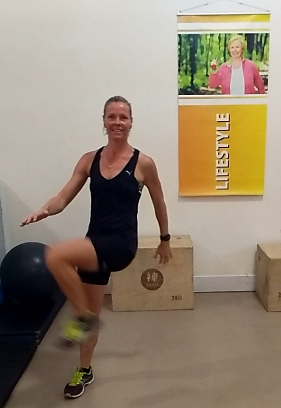Why a functional warm-up routine is a must.
The dynamic warm up routines on this page will prime your muscles for the workout and help negate the effects of our modern lifestyles. The exercises here focus on loosening up your muscles and joints, especially those that are tight as a result of sitting way too much. Tight muscles or joints are often the cause of many other problems, either directly or indirectly. Joints are designed to function in the mid-range of motion, but in order to stay healthy you also need to use the full range of motion. “Use it or lose it”, as the saying goes, is very true when it comes to range of motion. The aim with this functional movement warm-up is to gradually get your body to move correctly in your workouts and in your daily life.
When you can’t squat deep enough or you get injured easily while running, tight muscles or joints are often the culprit. With time, you will see how much easier it becomes. This warm-up will get the blood flowing to perform better at your workout. Your muscles and joints will loosen up and your brain will get the right signals which will ultimately make everything you do easier and lessen your chances of injury.
It is not advisable to do static stretching before exercising as there is no benefit and it may even increase your risk of injury. A dynamic warm-up is proven to be effective and the five minutes it takes is definitely worth it. Stretching can be done after you have trained.
Click on the highlighted text to see a short video of the routine. In order to keep the clips short, I only show a few reps of each exercise. Do this workout before your next workout, after a few times you will remember the routines and can make it part of you weekly program.
Don’t underestimate the importance of these routines. It is an integral part of staying younger for longer. Your improved functional movement ability will carry over to how efficient you train and how you feel and move in your daily life.
1)Crossed leg, one leg hip bridge x15
2)Lying Hip march x8 each leg
3)Side lying hip opener x8 each side
4)Side Lying Arm Crossover x15
5)Fire hydrant x 12 forwards, 12 backwards per leg
6)Slow motion mountain climber x 12 each leg
7)T-Spine rotation x 15
8)Groiners x 10 each side
1)Arm circles x 20. Small circles first 10, make bigger circles for last 10
2)Squats x 10. Go deep
3)Big step Lunges x 6-10 each leg
4)One leg Straight-leg hands to the floor x 10 per leg
5)Hip opener x 10 per leg
6)Quad stretch to butt and opposite arm reach x 10 each side
7)Standing knee to chest pull x 10 each leg
8)Lateral cross-over lunge x 8 each side
Warm-up #2 works best when you have enough space but it can be done in a small area too, although it works better if you can add three steps between each movement as shown in the video.
Optional:
25 each leg butt-kicks
10 each side two-step heismans
repeat
(Advanced add 25x Jumping Jacks and 25 squats for one or two sets to get the blood really flowing.)
You can do the same routine every time but it is best of you switch it up from time to time.
Here are two other short dynamic warm ups you can do before running.
I am not walking in the videos, but do these walking or moving 10-15m where the movement allows. For other exercise do 8-10 per side.
A word or two about Post workout static Stretching
Many people who exercise regularly spent way too much time stretching, often with no improvement in flexibility. There certainly can be benefits to include it when needed, but don’t waste 10-20 minutes every day doing it unless you have a good reason to do it.
Remember that unlike static stretching, dynamic warm-up is essential as it will help you train harder and it has proven benefits. Consider it part of your gym routine.
The following are my thoughts on static stretching, derived from the latest research and real life experience with clients:
- Recommended two to three times a week if your muscles are not as flexible as can be, or you do a lot of repetitive activities such as running or cycling.
- Always stretch warm muscles
- Any standard stretching routine will work.
- You don’t need to stretch each muscle each time. Instead, you can stretch tighter muscles such as (usually) hamstrings and calves more often. Tight calves often cause problems for runners, so it is advisable to stretch them more often if you run.
- Professionals can’t agree on the the most effective time to hold each stretch but one of the latest recommendations is to do the stretch for 10 sec, release and repeat 5 more times. I feel this work very well for hamstrings and other big or very tight muscles. I would suggest you start with this method, but after a week or two also do 30 sec stretch holds, but instead of six sets, do only 2 sets. Switch it up every now and again.
For example, week one do a “glute stretch” by holding the stretch for 10 sec before lowering your leg and releasing the tension. Repeat 6 times total.
Repeat for two weeks. In the third week , do the same exercise but hold for 30 sec. Do the other leg and repeat for a total of 2 stretches per leg. I would suggest doing this in cycles: 10s x 6 method for two weeks and the 30s x 2 for one week.
Here is a sample stretch routine I do from time to time when I feel my muscles are a bit tight or during/after a high volume training period.
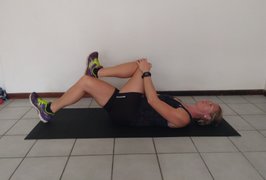
Pic 1: Glute Stretch. Pull knee to chest until you feel a stretch in your bum. Hold for 10 sec, release, repeat x6. Do this for all 5 stretches.
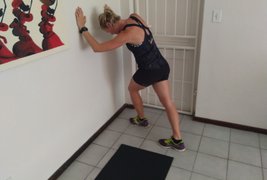
Pic 2: Hip Flexor stretch. Cross one foot in front of the other like shown. Push your hips sideways to the opposite direction.
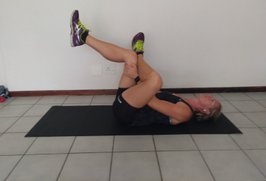
Pic 3:Hamstring stretch. Pull your bottom leg towards your chest. You’ll feel it in your hamstring of the crossed leg:
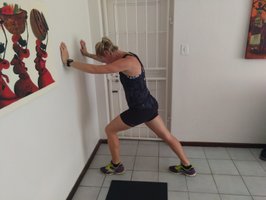
Pic 4: Upper calf stretch. Keep your feet secure and flat on ground, back leg straight and move your legs towards the wall to feel a stretch in back leg.
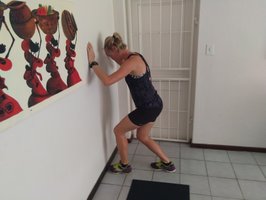
Pic 5: Lower calf stretch. By standing closer to the wall and both legs bent, you’ll feel a stretch in lower calf of back leg when you try and move your knee to the ground while keeping feet grounded.
Got any questions?
